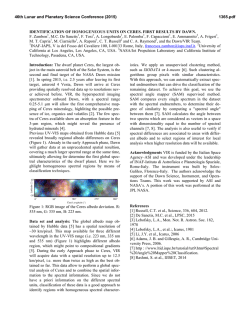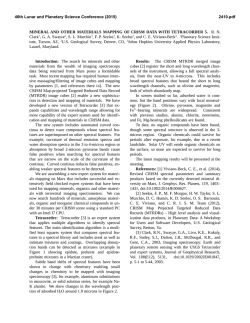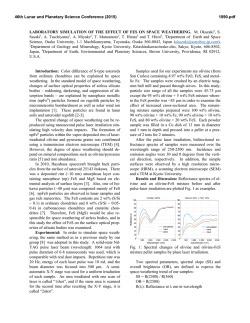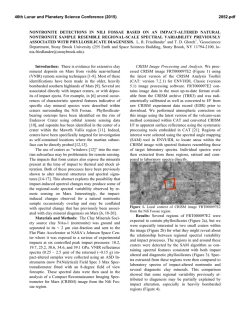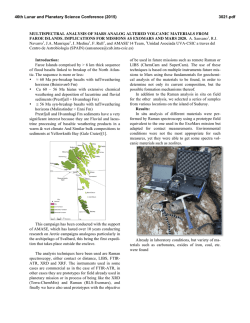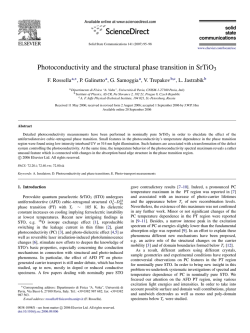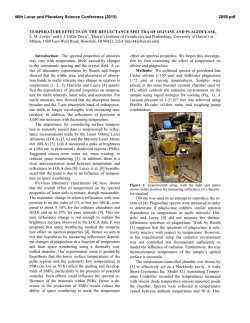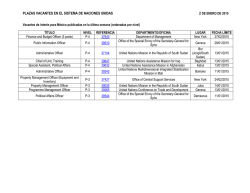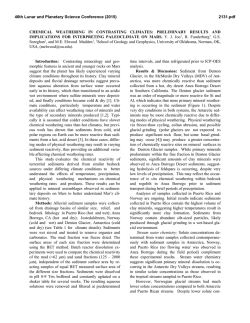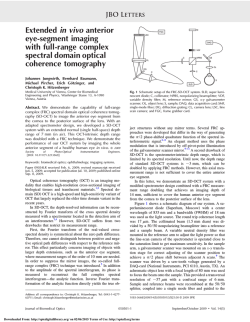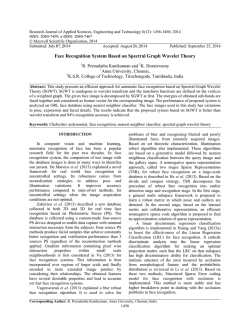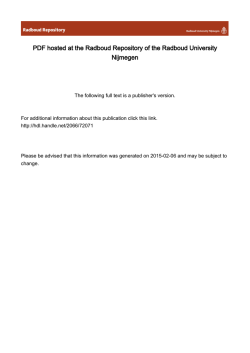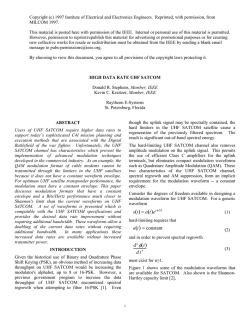
Space Weathering of Fe and Mg End
46th Lunar and Planetary Science Conference (2015) 2408.pdf SPACE WEATHERING OF FE AND MG END-MEMBER PHYLLOSILICATES. H. M. Kaluna1 and J. J. Gillis-Davis2, 1Institute for Astronomy, University of Hawaiʻi, Honolulu-HI-96822, 2Hawaiʻi Institute for Geophysics and Planetology, University of Hawaiʻi, Honolulu-HI-96822. Introduction: Space weathering effects are difficult to identify on C-type asteroids due to their low albedos and shallow absorption features [1,2]. Recent observational studies indicate that C-type asteroids do experience space weathering, but the results show contrasting trends. Two studies find the spectral slopes decrease with exposure age [3,4], whereas another finds the slopes increase (i.e. redden) [5]. Laboratory space weathering of carbonaceous chondrites (CCs) may offer clues towards solving the discrepancy found in asteroid observations. Experimental space weathering of CCs is still largely unexplored given the significant heterogeneity in CC compositions. Past ion bombardment and laser irradiation experiments on CCs also show a variety of spectral trends including darkening, brightening, reddening [5-8] and blueing (slope decrease) [9-11]. Hence, targeted experiments and observations are necessary to understand how individual components of CCs contribute to the complicated response of C-type space weathering. The aim of this work is to investigate the discrepancy between the spectral trends seen in space weathered C-type asteroids and CC meteorites by performing a targeted series of lab experiments. Our experimental work simulates micrometeorite impacts on phyllosilicate minerals, one of the major constituents in CCs. We compare the spectral response of two end-member phyllosilicates, cronstedtite (Fe22+Fe3+(SiFe3+)O5OH4) and serpentine (Mg3Si2O5)(OH4), with olivine, an anhydrous silicate. Methods: Each mineral was crushed and drysieved to <75 µm. X-ray diffraction analysis showed the lizardite to be 95% pure and the cronstedtite to be a mixture of cronstedtite, pyrite (FeS2) and siderite (FeCO3) (~73, 23 and 3 wt.% respectively). Samples were irradiated with a Nd:YAG, 1064 nm wavelength, pulsed laser. Laser spot size on the sample is 0.25 mm with an incident energy of 30mJ. A 20 Hz frequency and 6-8 nanosecond pulse duration was chosen to simulate timescales of real micrometeorite dust impacts [12]. The samples were irradiated at intervals of 2.5, 2.5, 5.0, 5.0, 5.0, 10.0, and 10.0 for a total of 40 minutes. Three 0.5g samples of each mineral were irradiated. Samples were irradiated as uncompressed powers and under vacuum pressures of 105 to 10-6 mbar. The partial pressure of H2O along with other volatiles was measured inline with a Stanford Research Systems 100 amu residual gas analyzer (RGA), which is a mass spectrometer consisting of a quadrupole probe. The RGA measured the partial pressure of the gases with time throughout the duration of the experiment. Spectral data were taken using a Vis/NIR (3502500nm) Analytical Spectral Devices Inc. (ASD) Fieldspec 4 spectroradiometer. Bidirectional reflectance spectra were acquired at a standard viewing geometry of i=30° and e=0°, and measured relative to a 99% reflectance LabSphere Spectralon Standard. Results: Spectral changes as a function of laser space weathering were measured for each mineral (Fig. 1). The most significant spectral changes were seen in the olivine slopes, which redden ~10x more than the phyllosilicates. The lizardite spectra also became redder with increased irradiation. The cronstedtite samples, however, initially redden then reverse and become bluer as irradiation time increased. Lizardite shows little to no changes in reflectance (our proxy for albedo) at all wavelengths, but olivine and cronstedtite both experience darkening in the visible and NIR. Initially the cronstedtite darkens more quickly in the visible than the NIR, but after ~10 minutes only the NIR continues to darken. Lizardite, which has a large suite of absorption bands in the visible and NIR, shows a smaller reduction in band depths at longer wavelengths. The RGA data show water released during irradiation are comparable for lizardite and cronstedtite at all stages of weathering. The water released by the phyllosilicates decreases slightly with increasing irradiation, but do not show evidence of dropping to olivine levels. These data suggest that the sample does not need to be fully dehydrated to have a spectral response to space weathering [13]. Discussion: Phyllosilicates are an important tracer of aqueous alteration. Modal mineralogy of CCs show a progression from Fe-cronstedtite to Mg-serpentines as aqueous alteration progresses from petrologic type 2 to 1 [14,15]. Furthermore, phyllosilicates can make up a significant fraction of CC meteorties (~80 wt. % in Murchison [16]), and have been detected in ~50% of C-type asteroids [17]. Hence we chose to focus on the response of phyllosilicates to simulated space weathering. Lizardite and cronstedtite are only two minerals in the phyllosilicate class, but these two Fe-Mg endmember compositions exhibit a divergent set of spectral trends. 46th Lunar and Planetary Science Conference (2015) Cronstedtite is the first mineral to show a decrease in spectral slopes in response to laser space weathering. Previously only organics have shown spectral blueing in response to ion bombardment [11]. The spectral blueing in cronstedtite appears to result from the continued darkening in the NIR while darkening saturates in the visible. Space weathering models of lunar materials attribute darkening and reddening to the optical influence of fine-grained iron particles 10's of nm in size [1]. Iron particles larger than 1µm will cause material to darken and not produce reddening [18]. The initial reddening in cronstedite is likely a result of the rapid production of small nm-sized particles. We postulate two possibilities for the spectral blueing that occurs after the first 10 minutes of laser irradiation. The first possibility is the production of iron particles greater than 1µm dominating the spectral properties of the sample beyond 10 minutes. The second possibility is the creation of a spectrally neutral phase (e.g. carbon from the breakdown of siderite). Both of these possibilities need to be examined with radiative transfer modeling and Transmission Electron Microscopy (TEM). Lizardite shows a small degree of darkening in the visible and no darkening in the NIR. The resulting spectra become redder as a function of laser space weathering. We interpret these spectral trends to be consistent with the production of fine grained iron particles like those seen in olivine and lunar soils. Conclusions: Our cronstedtite and lizardite samples yield different spectral responses to space weathering. The correlation of these two phyllosilicates with petrologic type suggests that both spectral reddening and blueing should be expected in the C-type population, as also observed by [19]. Further, the spectral response of C-type asteroid families to space weathering may be used to reveal the degree of aqueous alteration the parent body has experienced. Future work is necessary to understand the relative contribution of cronstedtite and serpentine to space weathering of carbonaceous materials (e.g., TEM and radiative transfer modeling). Additional lab experiments are needed to characterize the spectral behavior of other aqueous alteration products (e.g. carbon, carbonates, organics and oxides). References: [1] Hapke B. (2001) JGR, 106, 1003910074. [2] Chapman C. R. (2004) Annual Review of Earth and Planetary Science, 32, 539-567. [3] Nesvorny D. et al. (2005) Icarus, 173, 132-152. [4] Lantz C. et al. (2013) A&A, 554, A138. [5] Lazzarin M. et al. (2006) ApJ, 647, L179-182. [6] Moroz L. V. et al. (1996) Icarus, 122, 366-382. [7] Moroz L. V. et al. (2004) LPS XXXV, Abstract #1279. [8] Shingareva T. V. et al. (2004) LPS XXXV, Abstract #1137. [9] Hi- 2408.pdf roi T. et al. (2003) LPS XXXIIII, Abstract #1324. [10] Hiroi T. et al. (2004) LPS XXXV, Abstract #1616. [11] Moroz L. et al. (2004) Icarus, 170, 214-228. [12] Yamada M. et al. (1999) Earth, Planets and Space, 51, 1255. [13] Rivkin A. S. et al. (2002) Asteroids III, 235253. [14] Howard K. T. et al. (2009) Geochim. Cosmochim. Acta, 73, 4576-4589. [15] Howard K. T. et al. (2011) Geochim. Cosmochim. Acta, 75, 2735-2751. [16] Cloutis E. A. et al. (2011) Icarus, 216, 309-346. [17] Fornasier S. et al. (2014) Icarus, 233, 163-178. [18] Lucey P. G. and Riner M. A. (2011) Icarus, 212, 451-462. [19] Gillis-Davis, J. J. (2014) this LPSC. Acknowledgements: We would like to say mahalo nui to Karen Meech, Bin Yang, Patrick Gasda, Jeff Taylor, Eric Hellebrand, and Matt Markley for their help and support of this work. This material is based upon work supported by the National Aeronautics and Space Administration through the NASA Astrobiology Institute under Cooperative Agreement No. NNA04CC08A issued through the Office of Space Science, by NASA Grant No. NNX07A044G. a) b) Figure 1: a) Reflectance spectra of cronstedtite (blue), lizardite (green) and olivine (red) b) Reflectance spectra normalized to 0.55µm. The data follow the same color scheme as a).
© Copyright 2025
